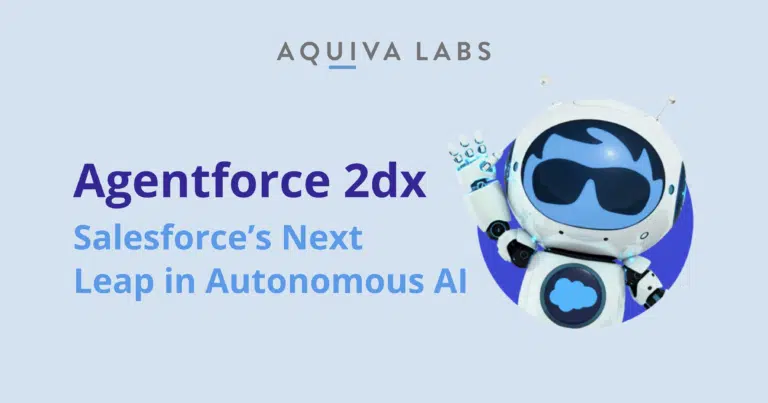When planning to build and launch an app on the Salesforce AppExchange, it’s easy to get caught up in all your great ideas for advanced features and functionality—and lose sight of what’s critical and what’s not.
But even grand plans start with small steps.
Facebook, for example, launched in 2004 (then called “Thefacebook”) and only connected students at Harvard with one another. And the first version of Uber, initially called UberCab, was only built to connect customers with cab drivers and accept payments. Over time, through ongoing market analysis and continuous product iteration, these tech behemoths turned the first versions of their products into the apps they are today.
This same approach should be taken when building a Salesforce app. As you set out to create your app, starting with a minimum viable product (MVP) should form a key part of your strategy. Building an MVP is a crucial aspect of the product development process, enabling you to list your product on the AppExchange as rapidly yet efficiently as possible. At the same time, an MVP can help you validate that you’re providing a genuine solution to end-user problems.
Rather than investing time and resources into developing an app that you haven’t even market-tested—and then relying on hindsight to illustrate your mistakes—shifting to an “MVP first” mindset is a far more effective approach.
In this article, we’ll explore what an MVP is, strategies for measuring the success of your MVP, and what should come after you hit that launch button.
What is an MVP?
Essentially, an MVP—also known as the minimum viable product—is the basic working version of your app. An MVP doesn’t include all the bells or whistles—but simply delivers the essential core features that add value to your customers. Ideally, it should address just one customer persona and solve their specific business problem, rather than being a “catch-all” solution that tries to solve multiple pain points. It’s unrealistic to be everything to everyone with the first version of your product.
As a basic prototype, it’s okay if your product team is slightly embarrassed by the MVP. In fact, LinkedIn co-founder Reid Hoffman is known for saying, “If you are not embarrassed by the first version of your product, you’ve launched too late.” Following lean startup principles, your MVP should be designed to allow you to collect the maximum amount of feedback—with the minimum amount of investment, effort, and time.
This first product iteration should help you identify assumptions and solutions as quickly and economically as possible, and identify user pain points and the functionality needed to address them.
What are the goals of an MVP?
Your MVP should come at the start of your Salesforce app development process, helping you validate your ideas and determine what direction is worth pursuing. In general, at least half of ideas just won’t work. An MVP should help you quickly identify and validate those ideas that will. And the rest? They can be discarded without any further investment.
Once your MVP validates your idea, expect to go through a few iterations to reach the stage where the idea actually delivers business value. This period is called time to money. And given that your ultimate goal is to drive revenue, it’s a far more valuable metric than time to market. Working with a Salesforce Product Development Outsourcer (PDO) is one way to streamline the MVP development process and avoid unnecessary investment into products that don’t actually solve a business problem.
How to measure the success of your MVP
As with most things, when it comes to measuring the success of your MVP—data trumps opinions. Any MVP should provide decision-makers with clean data they can use to improve future product iterations. Here at Aquiva Labs, we build products with a data-driven mindset to help achieve just that.
To measure your MVP’s success, both qualitative and quantitative data should be collected and analyzed
Qualitative data
Qualitative data is non-numerical. This type of data helps answer questions around who your customers are—and what problems or issues they face. This can help you identify where you should focus your attention so that you can solve these problems for them.
Conducting user interviews and surveys are effective methods to gain insights into customer sentiment. For example, if you find your app’s interface delivers a great user experience, your MVP is likely ready for the next stages of development.
Quantitative data
Quantitative data is numerical data. It can help inform your decision-making and keep your process focused and aligned on the end goal. With a range of metrics to choose from, it’s important to identify those that relate to the nature of your product. Common examples of metrics you may want to consider tracking in your MVP include:
- How often was the feature used?
- How many visits did a particular page have?
- How many times was a specific button clicked?
Life after the MVP
So, you’ve built your MVP and listed it on the Salesforce AppExchange. (Yay you!) All done, right? Well, not exactly.
Building a product is a process—not a destination. And the process isn’t over once you build and ship your MVP. In many ways, it’s just beginning.
Once you launch your MVP, the quantitative and qualitative data you collect should be used to identify any strengths and weaknesses of your current iteration. With these insights in hand—and by implementing a continuous cycle of discovery and delivery—you can create new product iterations that improve upon previous versions. Ultimately, this brings you closer to an end product that effectively addresses your customers’ most urgent—and often, evolving—needs and pain points.
When it comes to continuous iteration, there are two important phases of the app development lifecycle to focus on: product discovery and product delivery.
Product discovery
The product discovery phase helps separate the good ideas from the bad. The result of this discovery phase should be a validated product backlog, with four critical questions to address for each product:
- Will the user buy or choose to use this?
- Is the app user-friendly?
- Can our engineers build it?
- Can our stakeholders support it?
Through ongoing user research and testing of ideas, you can get the insights you need to refine and improve upon your app.
Product delivery
After product discovery comes delivery. While product discovery will inform your decisions about what to build, product delivery is about how you will build and ship a product that meets your customers’ needs.
This stage aims to build and deliver production-quality apps that you can sell to your customers, but that are also profitable and allow you to run your business successfully.
Achieving product/market fit
In the product world, product/market fit matters—it means that you’ve found a good market with a product capable of satisfying that market. Once you know your app can meet your target market’s needs, those customers will start to buy, use, and recommend your product. Continuous iteration will allow you to nail product/market fit—and, once you do achieve product/market fit, it’s also much easier to justify further investment.
When Instacart launched its app in 2012, for example, its founders didn’t have the resources or infrastructure needed to automate operations. So, if you placed an order on Instacart back then, the company’s founders were the ones manually processing your order, buying your groceries, and delivering them to your doorstep. Once they were able to validate their MVP and product-market fit, the founders were able to justify investment in building the backend infrastructure needed to scale.
Build fast and build right with an MVP
Building and launching your Salesforce app is a big achievement, but listing your app in the AppExchange isn’t the end of your journey. Working with an experienced Salesforce PDO like Aquiva Labs can help you quickly build and launch your MVP—but our engagement doesn’t stop there. By helping you continually leverage all the insights you’ll gain during the MVP development process, Aquiva Labs can help you achieve maximum, ongoing value from your app investment.
Need help developing your Salesforce MVP app?
Our experts can guide you through the Salesforce app development faster and easier than you ever thought possible. Contact one of our specialists today or check out Aquiva Labs’ AppExchange listing to see how we can help make your project a success.




